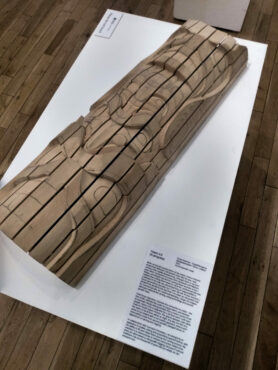Artists reflect on B.C.’s ancient forests in new display at Legacy Art Gallery

Carey Newman, 2022, Totem 2.0, Cedar Maquette. Photograph by Sarah Roberts.
Late last month, the art exhibition Still Standing: Ancient Forest Futures opened at the Legacy Art Gallery, reflecting upon our relationship with the old growth forests of B.C. Curated by Jessie Demers, the exhibit collects works by 12 artists, bridging gaps between art, ecology, and community activism.
As viewers on Victoria’s Yates Street flee into the Legacy Art Gallery to escape the oppressive summer heat, they may feel as if they have been cocooned in a shaded forest, immersed in the sounds of forest canopy, the atmosphere filled with the winds and calls of woodpeckers. A panoramic print of lush greens and mossy barks wraps around the gallery entrance. The intense detail of the photographic print accentuates the textures so much so that they appear three-dimensional.
The site-specific works entitled Treescape Revolution were created by UVic Visual Arts Associate Professor and artist Paul Walde, who uses sound compositions to connect with ecology. Walde created Treescape Revolution for the Eden Grove Artist in Residence Program — founded in 2021 by Demers.
With the permission of Pachehaadt communities, upon whose unceded territory Eden Grove stands, Demers invited artists to live and work in cedarwood forests, a short walk from the old-growth blockades.
The gallery pieces reflect the connections that artists have built, both with the landscape and with those fighting to protect it. In an email interview, Demers recalled, “Some of the artists spent many days and weeks in the forest and became intimately familiar with the ancient red cedars in the grove. Some also developed deep friendships with the forest protectors at Eden Camp, a nearby blockade, and these relationships fed into the artwork that was produced, telling stories of community, struggle, and resilience.”
In August 2021, a selection of artworks produced by several of the artist residents were displayed at Fortune Gallery in the show Last Stand: Ancient Forests, Collective Action. The Legacy’s current display, Still Standing, expands on that previous iteration, inviting viewers to consider the impacts of old-growth logging across Canada.
Demers cited the importance of working with First Nations peoples throughout the residency project.
“I created the residency program with the support of Pacheedaht Elder Bill Jones, Roxy Jones, and upcoming Hereditary Chief Victor Peter. They bravely spoke out against the logging plans on their territory, which their community was not consulted on, either by the colonial government or the elected Chief.”
On the first wall of Still Standing, a video produced with Bill Jones highlights the import of old-growth forests for members of his community, including the power of old growths in establishing equilibrium and balance. Alongside the recording, viewers can learn of the detailed histories of the Eden Grove camp and of the non-violent protests at Fairy Creek, which resulted in over 1 000 arrests.
Unfortunately, Eden Grove is not an isolated example of destructive logging practices. With just 2.7 per cent of the old growth in B.C. still intact, these issues deeply affect many communities. In the 2022 show at the Legacy, an additional four artists joined the eight from the Eden Grove project, pushing the discourse outwards.
Demers told the Martlet, “I’ve invited other artists to participate who have connections with old growth on their own territory such as Gord Hill (Kwakwaka’wakw), Jordan Hill (T’Souke), and Carey Newman (Kwakwaka’wakw and Sto:lo).”
Newman’s video, The Last Totem, portrays the artist’s profound personal conflict grappling with centuries of carving tradition and the ethics of sustainability. The accompanying Cedar Maquette, envisions his latest totem. The marked wood, freshly cut in preparation, echoes the artist’s unanswered question for the future, “What comes next?”
On the work, Demers commented, “I’m particularly excited about the forward vision of Carey’s ‘Totem 2.0’ Maquette and his video The Last Totem, which envisions a new way of making totem poles without cutting down ancient cedar trees.”
These artists draw on a plethora of new and traditional media techniques. One wall displays Jeremy Herndl’s arresting portrait, Black Cedar, which captures, in thickly layered oils, the resolute and sturdy power of ancient growth. Round a corner, Jordan Hill’s video installation, Horizontal Vertigo, is projected onto translucent and fine layers of chiffon.The fast camera work that recorded forest growth creates an urgent feeling of fleeting movement.
As Demers recognized, despite the differences in approach, a connecting thread runs through the entire show.
“Throughout all of the artists’ work is the awareness that we are all impacted by the colonial, capitalist notion of nature as a commodity to consume rather than a source of life we are all a part of and depend upon for survival,” Demers wrote.
“All of the artists challenge these colonial paradigms in their work in different ways and offer a vision for [a] future in which we have more reciprocal relationships with these ancient forests that have supported life for millennia — a future in which ancient forests remain standing.”
Participating artists include Carey Newman, Connie Morey, Gord Hill, Heather Kai Smith, Jeremy Herndl, Jordan Hill, Kelly Richardson, Kyle Scheurmann, Mike Andrew McLean, Paul Walde, Rande Cook, and Valerie Salez. Still Standing: Ancient Forest Futures will be open until Sept. 17, 2022.








